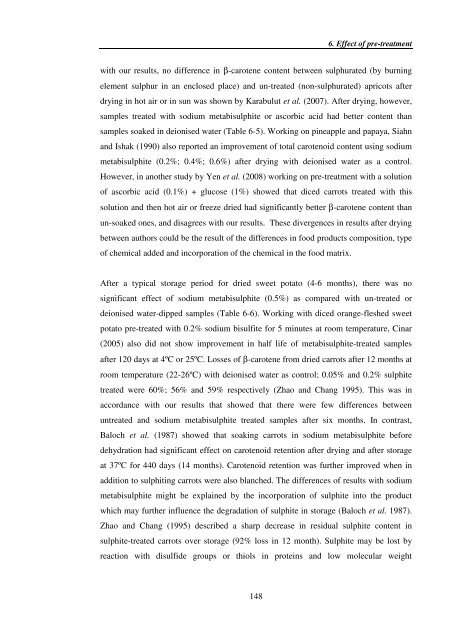Investigating carotenoid loss after drying and storage of
Investigating carotenoid loss after drying and storage of
Investigating carotenoid loss after drying and storage of
You also want an ePaper? Increase the reach of your titles
YUMPU automatically turns print PDFs into web optimized ePapers that Google loves.
148<br />
6. Effect <strong>of</strong> pre-treatment<br />
with our results, no difference in β-carotene content between sulphurated (by burning<br />
element sulphur in an enclosed place) <strong>and</strong> un-treated (non-sulphurated) apricots <strong>after</strong><br />
<strong>drying</strong> in hot air or in sun was shown by Karabulut et al. (2007). After <strong>drying</strong>, however,<br />
samples treated with sodium metabisulphite or ascorbic acid had better content than<br />
samples soaked in deionised water (Table 6-5). Working on pineapple <strong>and</strong> papaya, Siahn<br />
<strong>and</strong> Ishak (1990) also reported an improvement <strong>of</strong> total <strong>carotenoid</strong> content using sodium<br />
metabisulphite (0.2%; 0.4%; 0.6%) <strong>after</strong> <strong>drying</strong> with deionised water as a control.<br />
However, in another study by Yen et al. (2008) working on pre-treatment with a solution<br />
<strong>of</strong> ascorbic acid (0.1%) + glucose (1%) showed that diced carrots treated with this<br />
solution <strong>and</strong> then hot air or freeze dried had significantly better β-carotene content than<br />
un-soaked ones, <strong>and</strong> disagrees with our results. These divergences in results <strong>after</strong> <strong>drying</strong><br />
between authors could be the result <strong>of</strong> the differences in food products composition, type<br />
<strong>of</strong> chemical added <strong>and</strong> incorporation <strong>of</strong> the chemical in the food matrix.<br />
After a typical <strong>storage</strong> period for dried sweet potato (4-6 months), there was no<br />
significant effect <strong>of</strong> sodium metabisulphite (0.5%) as compared with un-treated or<br />
deionised water-dipped samples (Table 6-6). Working with diced orange-fleshed sweet<br />
potato pre-treated with 0.2% sodium bisulfite for 5 minutes at room temperature, Cinar<br />
(2005) also did not show improvement in half life <strong>of</strong> metabisulphite-treated samples<br />
<strong>after</strong> 120 days at 4ºC or 25ºC. Losses <strong>of</strong> β-carotene from dried carrots <strong>after</strong> 12 months at<br />
room temperature (22-26ºC) with deionised water as control; 0.05% <strong>and</strong> 0.2% sulphite<br />
treated were 60%; 56% <strong>and</strong> 59% respectively (Zhao <strong>and</strong> Chang 1995). This was in<br />
accordance with our results that showed that there were few differences between<br />
untreated <strong>and</strong> sodium metabisulphite treated samples <strong>after</strong> six months. In contrast,<br />
Baloch et al. (1987) showed that soaking carrots in sodium metabisulphite before<br />
dehydration had significant effect on <strong>carotenoid</strong> retention <strong>after</strong> <strong>drying</strong> <strong>and</strong> <strong>after</strong> <strong>storage</strong><br />
at 37ºC for 440 days (14 months). Carotenoid retention was further improved when in<br />
addition to sulphiting carrots were also blanched. The differences <strong>of</strong> results with sodium<br />
metabisulphite might be explained by the incorporation <strong>of</strong> sulphite into the product<br />
which may further influence the degradation <strong>of</strong> sulphite in <strong>storage</strong> (Baloch et al. 1987).<br />
Zhao <strong>and</strong> Chang (1995) described a sharp decrease in residual sulphite content in<br />
sulphite-treated carrots over <strong>storage</strong> (92% <strong>loss</strong> in 12 month). Sulphite may be lost by<br />
reaction with disulfide groups or thiols in proteins <strong>and</strong> low molecular weight






